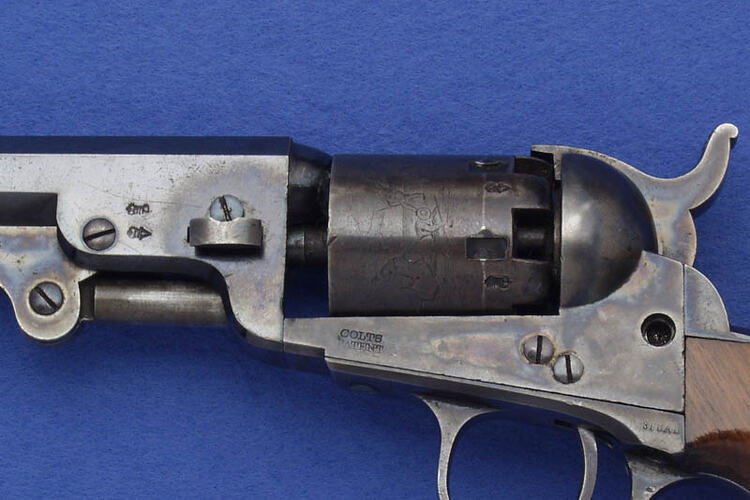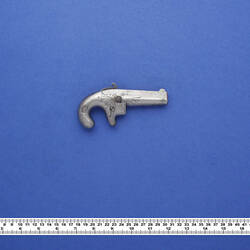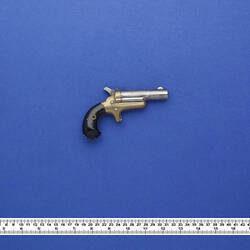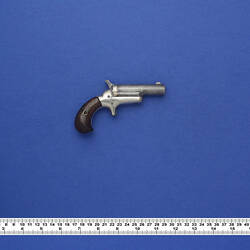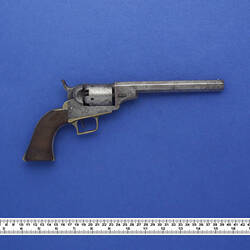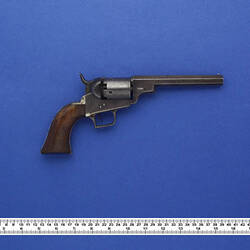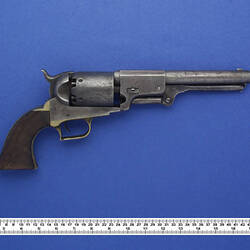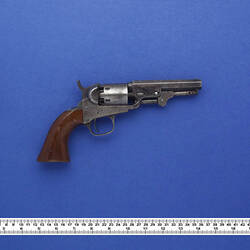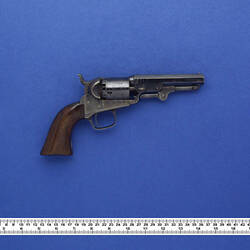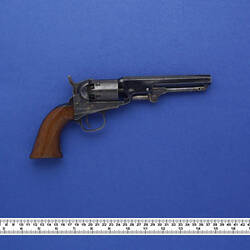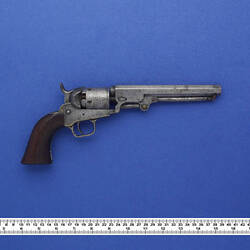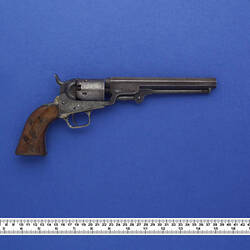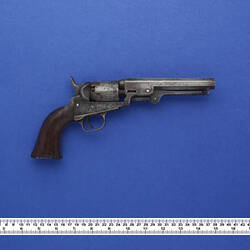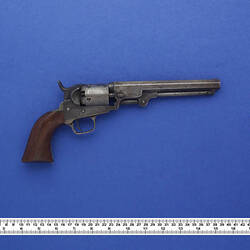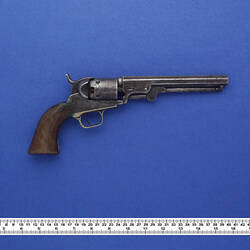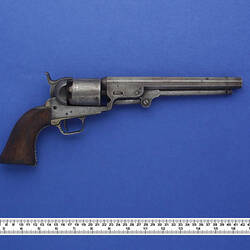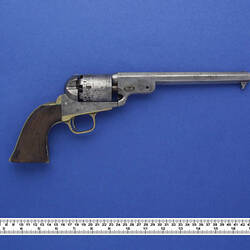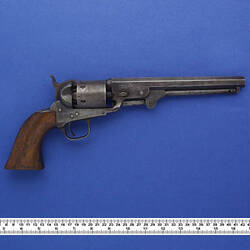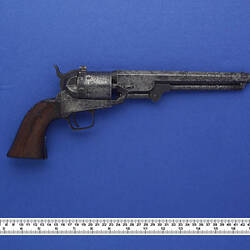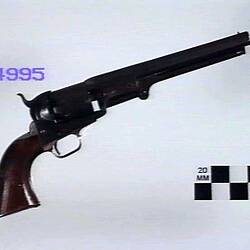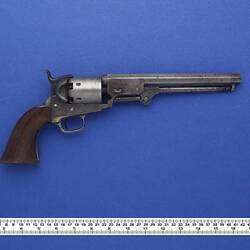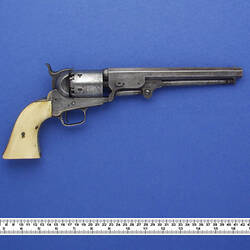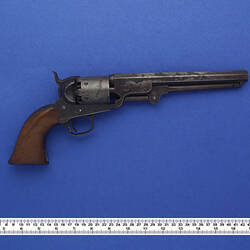Museum Victoria holds over 60 Colt firearms from the second half of the 19th century. This reflects the broad popularity in colonial Victoria for Colt firearms, recognised for their simplicity of design and robust construction.
Civilian introduction and use
The discovery of gold in Victoria in 1851 resulted in a massive population explosion as prospective diggers from across the globe rushed south with the hope of quick success. Many had already experienced the realities of the diggings, coming direct from America's west coast that had boomed following the 1848 Californian gold rush. Many of those entering Victoria from California and the US in the years immediately following the discovery of gold would have brought with them some means of self-defence, as numerous surviving accounts attest to the prevalence of assault and robbery going to, on, and leaving the Victoria goldfields.
It is clear that Colt firearms were already available amongst Victoria retailers by the mid-1850s. In early October 1854, the premises of Swanston Street watch importer, Louis Chevalier, was broken into and robbed of 180 watches. Amongst the additional items also taken, Chevalier was no doubt disappointed to lose an 'Army and Navy engraved Colt's Revolver, complete, in a case, with powder, balls, caps, & c.', offering a reward of fifty pounds for the return of the missing goods. (The Age, 17 October 1854, p. 1)
Ironmongers, gun retailers and general importers were all connected with the retail sale of firearms. One retailer, Ninnis of 82 Little Bourke Street East, was quick to recognise the promotional power of the name Colt, advertising that he was the 'cheapest house in Melbourne' for the supply of 'Colt's revolvers and other pistols'.
Upon reaching the goldfields, many found the seasoned diggers coming from America's west coast not only better dressed but were better armed: 'Coming in amongst the diggers [on the Ballarat diggings], nothing could possibly be more unlike in external appearance than that of the Californian and the Ballaratian. There was an air of comely chivalry about the former, bearded like a pard, with his steeple-crowned sombrero, and his wide coloured flannel shirt, girthed in above the hips with a red sash, that was stuck round with knives, daggers, and revolvers; while the latter, in the common-place garb of an ordinary navvie, without any more attractive-looking weapon than his tobacco-knife.' (Kelly, 1977, 180)
It is likely that the Californians' revolvers were Colts, and quite probably the popular 1851 Navy model. Larger, and with greater stopping power than the preceding smaller 1849 pocket model, they were a favourite sidearm for many on the diggings, and contemporary accounts often record revolvers amongst the arms carried by Americans on the goldfields.
The model later found additional fame in Victoria when railway guard, Jessie Dowsett, grappled a fallen Edward "Ned" Kelly at the siege of Glenrowan in 1880 to wrench an 1851 Navy revolver from his hand. In appreciation for his bravery, alongside an award of £175, Dowsett was presented with the revolver, as well as Kelly's mustard tin of cartridges. The revolver is now held in the collections of the National Trust of Australia (Victoria).
Victoria Police and Colt revolvers
Interest was first shown in equipping the Victoria Police force with Colt's revolvers in the early 1860s. Previously equipped with Adams and Kerr revolvers from London, in June 1864 Chief Commissioner of Police, Frederick Standish, stressed the deteriorating condition of the revolvers currently in use, observing that 'the present supply of revolvers now in use by the Police Force is not only insufficient, but rapidly becoming the worse for wear, citing 'peculiar complications in the mechanism of those last supplied (Adams' patent and Kerr's patent)'. He concluded that 'It is found on the contrary that Colt's Revolvers from the greater simplicity of their construction are far more suited for Police service; being easily cleaned, less liable to derangement, and far less dangerous'. (Frederick Standish, Chief Commissioner of Police to the Chief Secretary, 9 June 1864, Public Record Office of Victoria, VPRS 3991 P0 Unit 29, file: 64/ G5494)
A decision was made within a matter of weeks to heed Standish's recommendations and in July 1864 a tender advertisement appeared in the Victorian Government Gazette for '250 Colt's new model belt or navy pistol, 7 ½ barrel, 36 calibre, 6 shots; with mould and wrench, weight 2 lbs. 2 oz., to sample'. Across the late 1860s, the Police Colt Navies saw widespread use across the colony of Victoria.
In 1869, following advancements in the US and elsewhere to adopt an ignition system that employed metallic cartridges as opposed to the revolvers being loaded with loose powder and ball, an approach was made to the Victorian Government to undertake such a conversion locally. The offer was made by a local Melbourne gun retailer, 34 year-old James Rosier - the first of numerous dealings with the Victoria Police throughout the remainder of the century. The cost would be £1.12.6 per revolver, and - beginning in six months time to allow sufficient time to import the required parts - Rosier promised an output of between fifty and one hundred conversions a month. Rosier's bid for the conversions was successful, and appears on the statement of expenditure for the Police Store Vote at the end of 1870.
Museum Victoria holds two examples of Victoria Police issued Colt 1851 Navy revolvers, both having been converted to accept metallic cartridge ammunition on the Thuer patent. As per Rosier's description, one is equipped with the converted Thuer cylinder (ST 24574), the other retains its original percussion cylinder (ST 5751).
Although Rosier supplied a further 100 converted Colt Navy revolvers for the Mounted Police in 1873, the period of use of Colts by the Victoria Police was drawing to a close. By early 1874, 'Rosier converted' revolvers, as they were termed, were being returned to the Police Richmond Depot, to be replaced by Webley revolvers.
The Colts obviously remained in store, and perhaps in use across some regional districts, as late as the early 1880s when they were used at the Kelly siege at Glenrowan. But no further contracts were undertaken by the Victorian Government to purchase Colt revolvers for police use.
References:
The Age (29 December 1856), p.6.
Kelly, William (1977). Life in Victoria, or Victoria in 1853, and Victoria in 1858, [originally published London, 1859], Lowden Publishing, Kilmore.
More Information
-
Keywords
-
Authors
-
Article types
